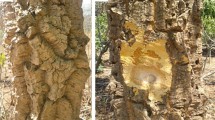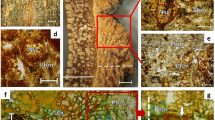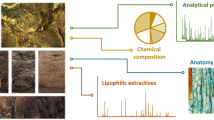Abstract
Cork is a material with a wide array of properties that make it uniquely suitable for many technological applications. All industrial cork comes from a single tree species, the cork-oak (Quercus suber L.), which is limited to the western Mediterranean region. A number of other trees and shrubs with “corky barks” are found in savannah-type ecosystems, namely in the Brazilian “Cerrado”, of which Kielmeyera coriacea Mart. and Zucc. (Pau-santo) is a conspicuous example. In this work, the chemical composition of K. coriacea outer bark as well as its extractives and suberin composition were analysed from the perspective of its potential use as an industrial cork source. K. coriacea outer bark showed a fairly high extractives content, ~15–20 %, with a significant proportion (6–10 %) of non-polar compounds, including very long chain (>C28) fatty acids (28 % of the dichloromethane extract) and xanthones (19 %). The suberin content varied from 17 to 30 %, total lignin from 44 to 55 % and the polysaccharides from 11 to 17 %, showing less suberin and polysaccharides and more lignin than the reference Q. suber cork. K. coriacea cork suberin composition was dominated by C18 mid-chain substituted ω-hydroxyacids and α,ω-diacids, with a noticeable absence of saturated chain monomers. Taking into account its cork content together with its cellular structure and chemical composition, K. coriacea outer bark is a potential source for cork. Although it might not be appropriate for solid cork products, it can be used to produce granulated cork for composite materials, or as a source of suberin-derived bio-based chemicals.




Similar content being viewed by others
References
BeMiller JN (1989) Carbohydrates. In: Rowe JW (ed) Natural products of woody plants I. Springer, Berlin, pp 155–178
Evert R (2006) Esau’s plant anatomy. Wiley, Hoboken
Fengel D, Wegener G (1989) Wood: chemistry, ultrastructure, reactions. Walter de Gruyter, Berlin
Gandini A, PascoalNeto C, Silvestre AJD (2006) Suberin: a promising renewable resource for novel macromolecular materials. Prog Polym Sci 31(10):878–892
Garcia-Cortez DAG, Young MCM, Marston A, Wolfender JL, Hostettmann K (1998) Xanthones, triterpenes and a biphenyl from Kielmeyera coriacea. Phytochemistry 47(7):1367–1374
Gil L (2009) Cork composites: a review. Materials 2(3):776–789
Graça J (2010) Hydroxycinnamates in suberin formation. Phytochem Rev 9(1):85–91
Graça J, Pereira H (2000) Methanolysis of bark suberins: analysis of glycerol and acid monomers. Phytochem Anal 11(1):45–51
Graça J, Santos S (2007) Suberin: a biopolyester of plants’ skin. Macromol Biosci 7(2):128–135
Guillemonat A, Triaca M (1968) Chemical constitution of cork. V. A preliminary study of Kielmeyera coriacea cork. Bull de la Société Chimique de Fr 3:950–952
Jové P, ÀngelsOlivella M, Cano L (2011) Study of the variability in chemical composition of bark layers of Quercus suber L. from different production areas. Bioresources 6(2):1806–1815
Marques AV, Pereira H, Meier D, Faix O (1999) Structural characterization of cork lignin by thioacidolysis and permanganate oxidation. Holzforschung 53(2):167–174
Miranda I, Gominho J, Pereira H (2012) Cellular structure and chemical composition of cork from the Chinese cork oak (Quercus variabilis). J Wood Sci 59(1):1–9
Natividade JV (1950) Cork oak forestry. Ministry of Economy, Directorate-general of forests and water services, Lisbon (in Portuguese)
Oliveira PS, Marquis RJ (2002) The cerrados of Brazil: ecology and natural history of a neotropical savanna. Columbia University Press, New York
Pereira H (1988a) Chemical composition and variability of cork from Quercus suber L. Wood Sci Technol 22(3):211–218
Pereira H (1988b) Structure and chemical composition of cork from Calotropis procera (Ait.) R. Br. Iawa Bull 9(1):53–58
Pereira H, Graça J, Baptista C (1992) The effect of growth rate on the structure and compressive properties of cork. IAWA Bull NS 13(4):389–396
Pereira H, Lopes F, Graca J (1996) The evaluation of the quality of cork planks by image analysis. Holzforschung 50(2):111–115
Pinto PCRO, Sousa AR, Silvestre AJD, Neto CP, Gandini A, Eckerman C, Holmbom B (2009) Quercus suber and Betula pendula outer barks as renewable sources of oleo chemicals: a comparative study. Ind Crops Prod 29(1):126–132
Pintor AMA, Ferreira CIA, Pereira JC, Correia P, Silva SP, Vilar VJP, Botelho CMS, Boaventura RAR (2012) Use of cork powder and granules for the adsorption of pollutants: a review. Water Res 46(10):3152–3166
Rios PD (2011) Anatomy and chemical characterization of Kielmeyera coriacea Mart. cork. Federal University of Lavras (Minas Gerais, Brazil) (in Portuguese)
Rios PD, Fábio AM, Barbos AC (2011) Morphological characterization of Kielmeyera coriacea Mart. cork from Brazilian Cerrado. Cerne 17(3):387–392
Santos S, Graça J (2006) Glycerol-omega-hydroxyacid-ferulic acid oligomers in cork suberin structure. Holzforschung 60(2):171–177
Sargianis J, Hyung-ick K, Jonghwan S (2012) Natural cork agglomerate employed as an environmentally friendly solution for quiet sandwich composites. Sci Rep 2(403):1–6
Schoeller Textiles (2012) Know-how and visions. Corkshell: naturally warm. http://www.schoeller-textiles.com/en/technologies/corkshell.html
Sen A, Miranda I, Santos S, Graça J, Pereira H (2010) The chemical composition of cork and phloem in the rhytidome of Quercus cerris bark. Ind Crops Prod 31(2):417–422
Sitte P (1962) Zum Feinbau der Suberinschichten im Flaschenkork. Protoplasma 54(4):555–559
Sousa AF, Pinto PCRO, Silvestre AJD, Neto CP (2006) Triterpenic and other lipophilic components from industrial cork by products. J Agric Food Chem 54(18):6888–6893
Sousa AF, Gandini A, Silvestre AJD, Pascoal Neto C, Cruz Pinto JJC, Eckerman C, Holmbom B (2011) Novel suberin-based biopolyesters: from synthesis to properties. J Polym Sci Part A-Polym Chem 49(10):2281–2291
Taylor D, Falk K, Palmer C, Hammerlindl J, Babic V, Mietkiewska E, Jadhav A, Marillia E, Francis T, Hoffman T, Giblin E, Katavic V, Keller W (2010) Brassica carinata—a new molecular farming platform for delivering bio-industrial oil feedstocks: case studies of genetic modifications to improve very long-chain fatty acid and oil content in seeds. Biofuels Bioprod Biorefining 4(5):538–561
Acknowledgments
We thank Andreíza C. Moreira, Adalberto C. Oliveira and Emilio M. Higashikawa for the field sampling and Joaquina Martins for technical assistance. We acknowledge CAPES-Coordenação de Aperfeiçoamento de Pessoal de Nível Superior for the research scholarship. The work was supported by FCT Project POCTI/QUI/70589/2006.
Author information
Authors and Affiliations
Corresponding author
Rights and permissions
About this article
Cite this article
Rios, P., Cabral, V., Santos, S. et al. The chemistry of Kielmeyera coriacea outer bark: a potential source for cork. Eur. J. Wood Prod. 72, 509–519 (2014). https://doi.org/10.1007/s00107-014-0811-y
Received:
Published:
Issue Date:
DOI: https://doi.org/10.1007/s00107-014-0811-y




